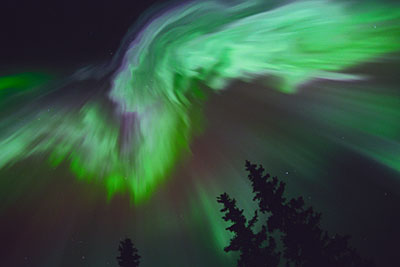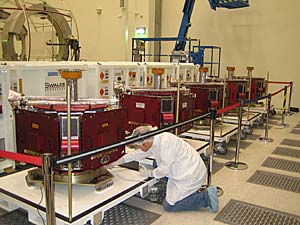UC Berkeley Press Release
 |
The colorful contortions in this aurora, filmed in Canada, are the result of substorms in the Earth's magnetic shield, the magnetosphere. The THEMIS spacecraft will pinpoint where intense blasts of solar wind enter the magnetosphere to trigger substorms. (Jan Curtis photo) |
THEMIS probes relocate to Florida for Feb. 15 launch
BERKELEY – NASA's THEMIS spacecraft - short for Time History of Events and Macroscale Interactions During Substorms - arrived in Florida today (Monday, Dec. 11), to begin final testing and launch preparations for a scheduled liftoff on Feb. 15.
THEMIS consists of five identical probes, the largest number of scientific satellites ever launched aboard a single rocket. This unique constellation of satellites, built by the University of California, Berkeley's Space Sciences Laboratory (SSL) and Swales Aerospace, will resolve the tantalizing mystery of what causes the spectacular sudden brightening of the auroral borealis - the fiery skies over the Earth's northern and southern poles. These lights are the visible manifestations of invisible energy releases, called substorms, in near-Earth space.
THEMIS will not only seek to answer the "holy grail" of space physics - where and when substorms start - but provide clues as to how and why these space storms create havoc on satellites, power grids and communication systems.
"This is a very exciting moment, where all the hard work we've put in over the last three years is finally coming to fruition," said THEMIS principal investigator Vassilis Angelopoulos, an assistant research physicist at SSL. "But seeing the data will be even more exciting. This is the end of one part of the mission, but the beginning of another."
THEMIS is the fifth medium-class mission under NASA's Explorer Program, which provides frequent flight opportunities for world-class scientific investigations from space concerning heliophysics and astrophysics. The Explorers Program Office at Goddard Space Flight Center in Greenbelt, Md., manages this NASA-funded mission.
 A technician readies the five THEMIS probes for transport to Florida and a Feb. 15 launch from Cape Canaveral. (Photo by Peter Harvey/UC Berkeley) |
Now that THEMIS has arrived at the Astrotech payload processing facility in Florida, each of the five probes will be removed from the shipping container in preparation for six weeks of testing and launch preparations. Led by THEMIS project manager Peter Harvey and supervised by integration manager Rick Sterling, the testing includes a functional performance test to verify the state of health of each of the five probes, installation of bolt cutters that will separate each probe from the payload carrier and pressurization and leak checks of the reaction control systems.
Each probe will then be moved to the hazardous processing facility and placed on a stand in preparation for fueling operations. Once fueling is complete, each probe will be weighed and individually mated to the payload carrier before pyrotechnics are installed. The fully integrated THEMIS spacecraft is then ready for spin balance testing and weighing of the completed payload. The final milestone is mating THEMIS to its upper stage booster. THEMIS will be transported to Pad 17-B at Cape Canaveral Air Force Station for mating to the Delta II rocket on Feb. 1.
The rocket that will launch THEMIS is a Boeing Delta II 7925-10. The first stage is scheduled to be erected on Pad 17-B the first week of January. The nine strap-on solid rocket boosters will be erected for attachment to the first stage during the second week of January. The second stage, which burns hypergolic propellants, will be hoisted atop the first stage during the third week of January. Finally, that same week, the fairing or housing which surrounds the spacecraft will be hoisted into the clean room of the mobile service tower.
Next, several tests of the Delta II will be performed. In the last week of January, as a leak check, the first stage will loaded with liquid oxygen during a simulated countdown. The next day, a simulated flight test will be performed without fuel aboard the vehicle's post-liftoff flight events. The electrical and mechanical systems of the entire Delta II will be exercised during this test. Once the THEMIS payload is atop the launch vehicle, a final major test will be conducted, an integrated test of the Delta II and THEMIS working together. This will be a combined minus count and plus count, simulating all events as they will occur on launch day, but without propellants aboard the vehicle.
Additional information:

